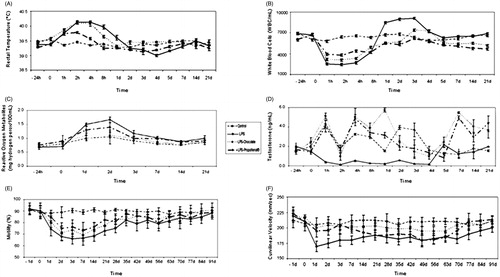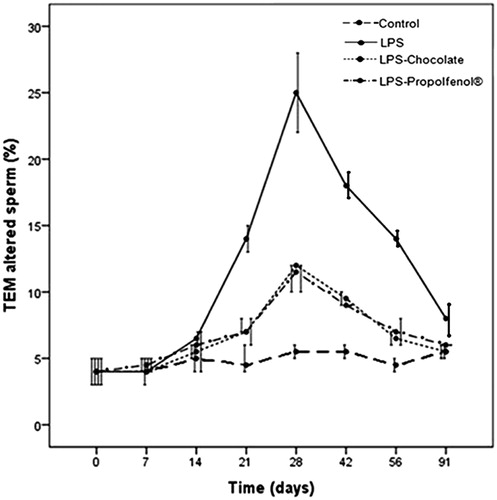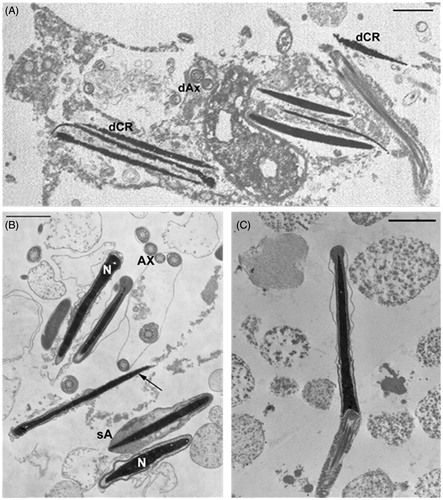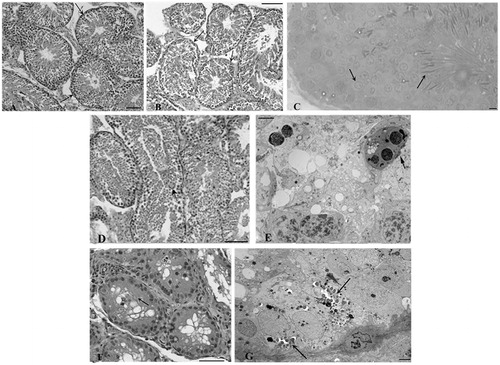Figures & data
Figure 1. Rectal temperature (A), white blood cell count (B), seminal reactive oxygen metabolites (C), blood testosterone (D), progressive sperm motility (E), and curvilinear velocity (F) in control, lipopolysaccharide (LPS), LPS-chocolate, and LPS-Propolfenol® treated rabbits (mean ± SD). The 95% confidence interval (upper and lower limits) obtained from the ANOVA model is reported.

Figure 2. Percentages of altered spermatozoa (median and interquartile range, 25th and 75th percentile) monitored by transmission electron microscopy (TEM) in control, lipopolysaccharide (LPS), LPS-chocolate, and LPS-Propolfenol®-treated rabbits. LPS-treated from 4% to 25%, LPS-chocolate and LPS-Propolfenol® altered sperm increased to, respectively, 12.0% and 11.5% at day 28, and successively returned to baseline. In controls, altered sperm was 4.0% and it remained constant up to the 91st day.

Figure 3. Micrographs of ejaculated spermatozoa (transmission electron microscopy). A) Spermatozoa from lipopolysaccharide (LPS)-treated rabbits (day 28 after LPS treatment) show altered plasma membranes, absent acrosomes, disorganized axoneme assembly (dAx) and disrupted chromatin (dCR); these alterations are typical characteristics of necrosis. B) Spermatozoa from LPS-chocolate-treated rabbits (day 28 after LPS treatment) show regular nuclei (N), acrosomes, and axonemes (Ax); spermatozoa with swollen (sA) or absent (arrow) acrosomes are also present. C) Normal spermatozoon from a LPS-Propolfenol® -treated rabbit. Bar 1 μm.

Figure 4. Micrographs of testicular tissue examined by optical and transmission electron microscopy. Samples of control (A) and lipopolysaccharide (LPS)-Propolfenol® -treated rabbits (B, C day 7 after LPS treatment) show tubules (black arrows) with a normal germinal epithelium (white arrows). In C) spermatids (arrows) at different stages of maturation are visible. D, E) Rare spermatocytes intermingled with ballooning Sertoli cells were detected (day 7 after LPS treatment, arrow) in a rabbit treated with chocolate, detected by optical (D) and transmission electron microscopy (E). F) LPS-treated rabbits (day 7 after LPS treatment), the tubules show a conspicuous reduction in the germinal epithelium (arrows). G) the presence of an increased number of Sertoli cells with abundant dark lysosomes is indicated (arrows). A,B,C, F: bar 100 μm, D: bar 4 μm, E: bar 10 μm, G: bar 2 μm.

Figure 5. Relative abundance of toll-like receptor4 (TLR-4) mRNA in testis (A) and epididymis (B) harvested from control (lane C), lipopolysaccharide (LPS) treated, LPS-chocolate (LPS/ch), LPS-Propolfenol® (LPS/Pr)-treated rabbits. The upper panels show representative images of ethidium bromide stained gels showing the presence of the expected bp products yielded after reverse transcriptase polymerase chain reaction using primers for target TLR-4 (123 bp) and 18S (324 bp). Lane LD is the kb DNA marker. For each experimental group, the values (means ± SD) derived from densitometric analyses of TLR-4 reported in arbitrary units relative to 18S expression, combined with the results from two different rabbits for each experimental group (C). Different letters indicate a significantly different value (p < 0.01).

Table 1. Primers for TLR4.
